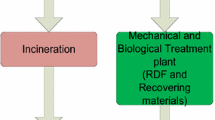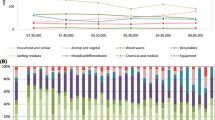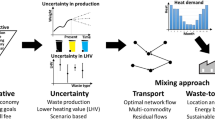Abstract
Waste-to-energy supply chains are important potential contributors to minimising the environmental impacts of municipal solid waste by reducing the amounts of waste sent to landfill, as well as the fossil fuel consumption and environmental footprints. Accounting for the spatial and transport properties of the waste-to-energy supply chains is crucial for understanding the problem and improving the supply chain designs. The most significant challenge is the distributed nature of the waste generation and the household energy demands. The current work proposes concepts and a procedure for targeting the size of the municipal solid waste collection zone as the first step in the waste-to-energy supply chains synthesis. The formulated concepts and the provided case study reveal trends of reducing the net greenhouse gas savings and energy recovery by increasing the collection zone size. Population density has a positive correlation with the greenhouse gas saving and energy recovery performance. For smaller zone size the energy recovery from waste approaches and in some cases may surpass the energy spent on waste transportation. The energy recovery and greenhouse gas savings remain significant even for collection zones as large as 200 km2. The obtained trends are discussed and key directions for future work are proposed.

Similar content being viewed by others
References
Nagy T, Mizsey P. Model verification and analysis of the CO2-MEA absorber–desorber system. International Journal of Greenhouse Gas Control, 2015, 39: 236–244
Fan Y V, Varbanov P S, Klemeš J J, Nemet A. Process efficiency optimisation and integration for cleaner production. Journal of Cleaner Production, 2018, 174: 177–183
Fodor Z, Klemeš J J. Waste as alternative fuel—Minimising emissions and effluents by advanced design. Process Safety and Environmental Protection, 2012, 90(3): 263–284
Boumanchar I, Chhiti Y, Alaoui F E M H, El Ouinani A, Sahibed-Dine A, Bentiss F, Jama C, Bensitel M. Effect of materials mixture on the higher heating value: Case of biomass, biochar and municipal solid waste. Waste Management (New York, N.Y.), 2017, 61: 78–86
Das S, Bhattacharyya B K. Optimization of municipal solid waste collection and transportation routes. Waste Management (New York, N.Y.), 2015, 43: 9–18
Zhang Y, Huang G H, He L. A multi-echelon supply chain model for municipal solid waste management system. Waste Management (New York, N.Y.), 2014, 34(2): 553–561
Cucchiella F, D’Adamo I, Gastaldi M. Sustainable management of waste-to-energy facilities. Renewable & Sustainable Energy Reviews, 2014, 33: 719–728
Xu Z, Elomri A, Pokharel S, Zhang Q, Ming X G, Liu W. Global reverse supply chain design for solid waste recycling under uncertainties and carbon emission constraint. Waste Management (New York, N.Y.), 2017, 64: 358–370
Longden D, Brammer J, Bastin L, Cooper N. Distributed or centralised energy-from-waste policy? Implications of technology and scale at municipal level. Energy Policy, 2007, 35(4): 2622–2634
Gandy M. Political conflict over waste-to-energy schemes. Land Use Policy, 1995, 12(1): 29–36
Pirotta F J C, Ferreira E C, Bernardo C A. Energy recovery and impact on land use of Maltese municipal solid waste incineration. Energy, 2013, 49: 1–11
Mavrotas G, Gakis N, Skoulaxinou S, Katsouros V, Georgopoulou E. Municipal solid waste management and energy production: Consideration of external cost through multi-objective optimization and its effect on waste-to-energy solutions. Renewable & Sustainable Energy Reviews, 2015, 51: 1205–1222
Stasta P, Boran J, Bébar L, Stehlík P, Oral J. Thermal processing of sewage sludge. Applied Thermal Engineering, 2006, 26(13): 1420–1426
Kilkovsky B, Stehlík P, Jegla Z, Tovazhnyansky L L, Arsenyeva O, Kapustenko P O. Heat exchangers for energy recovery in waste and biomass to energy technologies—I. Energy recovery from flue gas. Applied Thermal Engineering, 2015, 64(1-2): 213–223
Murphy J D, McKeogh E. Technical, economic and environmental analysis of energy production from municipal solid waste. Renewable Energy, 2004, 29(7): 1043–1057
Nazmul Islam K M. Greenhouse gas footprint and the carbon flow associated with different solid waste management strategy for urban metabolism in Bangladesh. Science of the Total Environment, 2017, 580: 755–769
Tavares G, Zsigraiová Z, Semiao V. Multi-criteria GIS-based siting of an incineration plant for municipal solid waste. Waste Management (New York, N.Y.), 2011, 31(9-10): 1960–1972
Murphy F, Sosa A, McDonnell K, Devlin G. Life cycle assessment of biomass-to-energy systems in Ireland modelled with biomass supply chain optimisation based on greenhouse gas emission reduction. Energy, 2016, 109: 1040–1055
Šomplák R, Nevrlý V, Smejkalová V, Pavlas M, Kudela J. Verification of information in large databases by mathematical programming in waste management. Chemical Engineering Transactions, 2017, 61: 985–990
Walmsley T G, Varbanov P S, Klemeš J J. Networks for utilising the organic and dry fractions of municipal waste: P-graph approach. Chemical Engineering Transactions, 2017, 61: 1357–1362
Nelles M, Grünes J, Morscheck G. Waste management in Germany—Development to a sustainable circular economy? Procedia Environmental Sciences, 2016, 35: 6–14
Dekker R, Fleischmann M, Inderfurth K, Wassenhove LN. Reverse Logistics: Quantitative Models for Closed-Loop Supply Chains. Heidelberg: Springer Science & Business Media, 2013
Chalkias C, Lasaridi K. Benefits from GIS Based Modelling for Municipal Solid Waste Management. In: Kumar S, ed. Integrated Waste Management—Vol I. London: InTech, 2011, DOI 10.5772/17087
Council Directive 1999/31/EC of 26 April 1999 on the landfill of waste, Official Journal L 182, 16/07/1999, 0001–0019
Peng W, Pivato A. Sustainable management of digestate from the organic fraction of municipal solid waste and food waste under the concepts of back to earth alternatives and circular economy. Waste and Biomass Valorization, 2017, https://doi.org/10.1007/s12649-017-0071-2
Friedler F, Varga J B, Fehér E, Fan L T. Combinatorially accelerated branch-and-bound method for solving the MIP model of process network synthesis. In: Floudas C A, Pardalos P M, eds. State of the Art in Global Optimization. Massachusetts, USA: Kluwer Academic Publishers, 1996, 609–626
Kravanja Z. Challenges in sustainable integrated process synthesis and the capabilities of a MINLP process synthesizer MipSyn. Computers & Chemical Engineering, 2010, 34(11): 1831–1848
Branchini L. Municipal waste overview In: Waste-to-Energy, Chapter 2. Switzerland: Springer International Publishing, 2015, 7–17
Varbanov P S, Lam H L, Friedler F, Klemeš J J. Energy generation and carbon footprint of waste to energy. Centralised vs. distributed processing. Computer-Aided Chemical Engineering, 2012, 31: 1402–1406
Berglund M, Börjesson P. Assessment of energy performance in the life-cycle of biogas production. Biomass and Bioenergy, 2006, 30 (3): 254–266
Johnston M A. Managing odors at anaerobic digestion plants. BioCycle, 2017, 58(3): 39
Tan S T, Lee C T, Hashim H, Ho W S, Lim J S. Optimal process network for municipal solid waste management in Iskandar Malaysia. Journal of Cleaner Production, 2014, 71: 48–58
Pavlas M, Šomplák R, Smejkalová V, Nevrlý V, Szásziová L, Kudela J, Popela P. Spatially distributed production data for supply chain models—Forecasting with hazardous waste. Journal of Cleaner Production, 2017, 161: 1317–1328
Nevrlý V, Šomplák R, Gregor J, Pavlas M, Klemeš J. Impact on the Population from the Transportation of Waste based on Emission Models. In: Proceedings of SDEWES 2017—12th Conference on Sustainable Development of Energy, Water and Environmental Systems. Zagreb: Faculty of Mechanical Engineering and Naval Architecture, 2017, 1–14
Acknowledgements
This research has been supported by the EU project “Sustainable Process Integration Laboratory—SPIL”, project No. CZ.02.1.01/0.0/0.0/15_003/0000456 funded by EU “CZ Operational Programme Research, Development and Education”, Priority 1: Strengthening capacity for quality research and under the cooperation agreement with The University of Manchester, UK.
Author information
Authors and Affiliations
Corresponding author
Rights and permissions
About this article
Cite this article
Varbanov, P.S., Walmsley, T.G., Fan, Y.V. et al. Spatial targeting evaluation of energy and environmental performance of waste-to-energy processing. Front. Chem. Sci. Eng. 12, 731–744 (2018). https://doi.org/10.1007/s11705-018-1772-1
Received:
Accepted:
Published:
Issue Date:
DOI: https://doi.org/10.1007/s11705-018-1772-1




